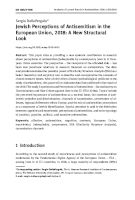Jewish Perceptions of Antisemitism in the European Union, 2018: A New Structural Look
Author(s)
Publication Name
Publication Date
Abstract
This paper aims at providing a new systemic contribution to research about perceptions of antisemitism/Judeophobia by contemporary Jews in 12 European Union countries. The perspective – the viewpoint of the offended side – has been less prominent relatively in research literature on antisemitism. The data analysis demonstrates the potential power of Similarity Structure Analysis (SSA) as a better theoretical and empirical tool to describe and conceptualize the contents of chosen research issues. After a brief review of some methodological problems in the study of antisemitism, this paper will re-elaborate data first published in the report of the 2018 FRA study Experiences and Perceptions of Antisemitism – Second survey on Discrimination and Hate Crimes against Jews in the EU (FRA 2018a). Topics include the perceived importance of antisemitism as a societal issue, the contents of anti-Jewish prejudice and discrimination, channels of transmission, perpetrators of offenses, regional differences within Europe, and the role of antisemitism perceptions as a component of Jewish identification. Special attention is paid to the distinction between cognitive and experiential perceptions of antisemitism, and to the typology of practical, populist, political, and narrative antisemitism.
Topics
Genre
Geographic Coverage
Austria Belgium Denmark France Europe Germany Hungary Italy Netherlands Poland Spain Sweden United Kingdom
Original Language
Volume/Issue
40(2)
Related
DOI
Link
Link to article, Jewish Perceptions of Antisemitism in the European Union, 2018: A New Structural Look
Bibliographic Information
Jewish Perceptions of Antisemitism in the European Union, 2018: A New Structural Look. 2020: https://archive.jpr.org.uk/10.1515/actap-2020-2001




